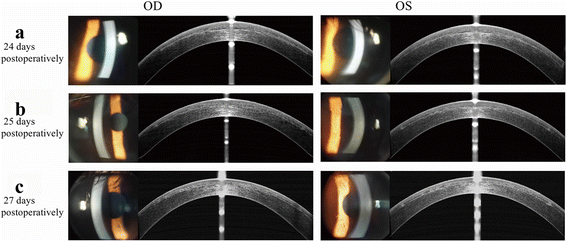Corneal densitometry changes in a patient with interface fluid syndrome after small incision lenticule extraction
- PMID: 28356099
- PMCID: PMC5372330
- DOI: 10.1186/s12886-017-0428-0
Corneal densitometry changes in a patient with interface fluid syndrome after small incision lenticule extraction
Abstract
Background: To report a case of interface fluid syndrome (IFS) following small incision lenticule extraction (SMILE) evaluated with corneal densitometry and optical coherence tomography (OCT).
Case presentation: An 18-year-old man reported sudden vision loss 24 days after SMILE procedure. Intraocular pressure (IOP) was 36.3 mmHg (OD) and 36.7 mmHg (OS) by noncontact tonometry. Moderate corneal edema, interface fluid pocket and haze were observed by OCT and confirmed by corneal densitometry values. Discontinuation of steroids and addition of hypotensive medication were offered immediately. The symptoms were cured after the medication. Changes of corneal densitometry were consistent with the clinical course of IFS.
Conclusion: This case illustrates that it is crucial to be aware that a history of SMILE can also cause IFS. Both OCT and corneal densitometry can serve as auxiliary means to evaluate the clinical course of IFS, and appropriate IOP management is an effective approach.
Keywords: Corneal densitometry; Interface fluid syndrome (IFS); Small incision lenticule extraction (SMILE).
Figures

Similar articles
-
Interface fluid syndrome caused by the corneal perforation injury after small incision lenticule extraction: a case report.BMC Ophthalmol. 2024 Mar 13;24(1):117. doi: 10.1186/s12886-024-03339-3. BMC Ophthalmol. 2024. PMID: 38481187 Free PMC article.
-
Changes in intraocular pressure values measured with noncontact tonometer (NCT), ocular response analyzer (ORA) and corvis scheimpflug technology tonometer (CST) in the early phase after small incision lenticule extraction (SMILE).BMC Ophthalmol. 2016 Nov 18;16(1):205. doi: 10.1186/s12886-016-0381-3. BMC Ophthalmol. 2016. PMID: 27863469 Free PMC article.
-
Shifting "Ectasia": Interface Fluid Collection After Small Incision Lenticule Extraction (SMILE).J Refract Surg. 2016 Nov 1;32(11):773-775. doi: 10.3928/1081597X-20160721-02. J Refract Surg. 2016. PMID: 27824382
-
Recalcitrant Epithelial Ingrowth After SMILE Treated With a Hydrogel Ocular Sealant.J Refract Surg. 2015 Dec;31(12):847-50. doi: 10.3928/1081597X-20151111-09. J Refract Surg. 2015. PMID: 26653731 Review.
-
Late-onset interface fluid syndrome: A case report and literature review.Semin Ophthalmol. 2022 Oct-Nov;37(7-8):839-848. doi: 10.1080/08820538.2022.2102928. Epub 2022 Jul 21. Semin Ophthalmol. 2022. PMID: 35866219 Review.
Cited by
-
Interface fluid syndrome after small incision lenticule extraction surgery secondary to posner schlossman syndrome - A case report.Heliyon. 2023 Nov 4;9(11):e21863. doi: 10.1016/j.heliyon.2023.e21863. eCollection 2023 Nov. Heliyon. 2023. PMID: 38027722 Free PMC article.
-
Complications of small incision lenticule extraction.Indian J Ophthalmol. 2020 Dec;68(12):2711-2722. doi: 10.4103/ijo.IJO_3258_20. Indian J Ophthalmol. 2020. PMID: 33229647 Free PMC article. Review.
-
Interface fluid syndrome: A potential lifelong complication after LASIK. A case report.Am J Ophthalmol Case Rep. 2018 Apr 19;11:23-25. doi: 10.1016/j.ajoc.2018.04.020. eCollection 2018 Sep. Am J Ophthalmol Case Rep. 2018. PMID: 30073213 Free PMC article.
-
Interface fluid syndrome caused by the corneal perforation injury after small incision lenticule extraction: a case report.BMC Ophthalmol. 2024 Mar 13;24(1):117. doi: 10.1186/s12886-024-03339-3. BMC Ophthalmol. 2024. PMID: 38481187 Free PMC article.
-
Glaucoma and refractive surgery: A comprehensive review.Indian J Ophthalmol. 2024 Sep 1;72(9):1244-1253. doi: 10.4103/IJO.IJO_3236_23. Epub 2024 Aug 23. Indian J Ophthalmol. 2024. PMID: 39185827 Free PMC article. Review.
References
-
- Moya Calleja T, Iribarne Ferrer Y, Sanz Jorge A, Sedo FS. Steroid-induced interface fluid syndrome after LASIK. J Refract Surg. 2009;25(2):235–239. - PubMed
Publication types
MeSH terms
LinkOut - more resources
Full Text Sources
Other Literature Sources

